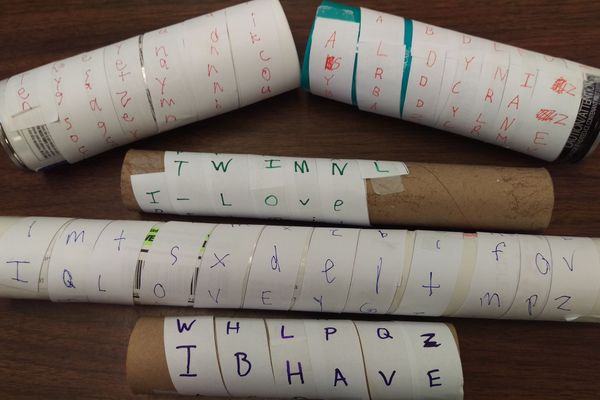Share secret messages with a scytale
Make a scytale cipher using a cardboard tube and paper strip, encode and decode secret messages, and explore simple ancient encryption.



Step-by-step guide to make a scytale cipher
Make a Scytale Cipher || Science for Kids at Home
Step 1
Gather all the materials from the list and bring them to a clear table or floor space.
Step 2
Lay the cardboard tube on the paper and use the pencil to trace along the length of the tube to mark how long your strip should be.
Step 3
Use the ruler to draw two straight parallel lines about 2 to 3 centimeters apart along the traced area to mark the strip width.
Step 4
Cut out the paper strip along the lines using scissors.
Step 5
Wrap the paper strip snugly around the tube so the ends meet and tape or glue the ends to hold it in place.
Step 6
With the strip wrapped on the tube use the marker to write your secret message in one straight line along the length of the tube so letters sit across the wrapped turns.
Step 7
Carefully slide the paper off the tube and lay the strip flat to see the scrambled secret message.
Step 8
To decode the message wrap the scrambled strip back around the same size tube so the ends match and read the letters along the line to reveal the original message.
Step 9
Write a new secret message and give the scrambled strip to a friend or family member to decode.
Step 10
Try using a different size tube or a wider strip and observe how the encoded message looks different.
Step 11
Decorate or color your strip to make your scytale look ancient or mysterious.
Step 12
Share your finished scytale and secret messages on DIY.org
Final steps
You're almost there! Complete all the steps, bring your creation to life, post it, and conquer the challenge!


Help!?
What can we use if we don't have a cardboard tube?
If you don't have a cardboard tube, roll a piece of thin cardboard or use a similarly sized marker, glue stick, or paper towel tube and tape it so the paper strip can be wrapped snugly.
My decoded message looks scrambled—what went wrong?
If the decoded message is scrambled, make sure you wrapped the paper strip snugly with the ends matched and wrote the secret in one straight line while the strip was on the tube as the instructions say.
How can I adapt this activity for different age groups?
For younger kids, an adult can pre-trace and pre-cut the 2–3 cm paper strip and help tape it to the tube, while older kids can measure with the ruler themselves and try different-size tubes or wider strips to increase the challenge.
How can we make the scytale more creative or harder to decode?
As the instructions suggest, decorate or color your strip and also try different-size tubes or wider strips and even add a letter-number substitution to create a personalized, layered secret message.
Watch videos on how to make and use a scytale cipher
Cipher Wheel: How To Assemble And Use A Cipher Wheel To Decode Secret Messages
Facts about classical cryptography
⏳ The scytale is one of the oldest-known cryptographic tools and inspired later secret-writing methods.
🔁 A scytale is a transposition cipher: it keeps the same letters but rearranges their order to hide the message.
🪵 The scytale was used by ancient Spartans as a rod-and-strip cipher — wrap a strip around a rod to read the secret message!
📏 The thickness (circumference) of the rod acts as the 'key' — the message only lines up correctly on a rod of the right size.
🏺 The word 'scytale' comes from the Greek skytalē, which can mean a baton, rod, or strip of leather.
How do you make and use a scytale cipher?
What materials do I need for a scytale cipher activity?
What ages is the scytale cipher suitable for?
What are the benefits of making a scytale cipher?


One subscription, many ways to play and learn.
Only $6.99 after trial. No credit card required



